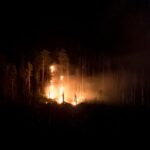On the morning of Thursday, July 25, responders at the Miller Peak and Butler Creek fires rushed to locate areas of spread and spot fires caused by the previous night’s extreme winds. But Wednesday’s gusts had a limited impact on the Butler Creek Fire, a 284-acre blaze just five miles northwest of Missoula.
“While it was very windy up on the fire, nothing really happened. Nothing really started up,” said Olivia Anderson, a fire-adapted communities coordinator with the state Department of Natural Resources and Conservation. The Butler Creek Fire began on Monday, making it the only major wildfire to start in Montana since the Deadman Fire began on July 12. On Friday, the Butler Creek Fire was almost entirely contained.
Meanwhile, seven miles southwest of Missoula, the Miller Peak Fire is just 48 hours from its two-week birthday. On Wednesday night, meteorologists recorded sustained gusts of 60 mph in the areas and, at higher elevations, winds as fast as 109 mph.
“The fire has stayed in its operational footprint,” Operations Section Chief Greg Schenk said in a video statement posted online Thursday. “It has not moved outside of its lines. We have not discovered any new spots.”
On Friday, the Miller Peak blaze was partially contained at 2,631 acres by a team of 787 responders, the largest force currently deployed to a single fire in Montana.
With 95 personnel, the Horse Gulch Fire just east of Helena ranks second. The state has been diverting resources away from Horse Gulch since July 17, when 616 people were working at the site. The Horse Gulch Fire is now almost entirely contained.

The Deadman, McGhee, Prairie, and Four Mile fires — four distinct blazes burning in a complex covering 47,827 acres in southeast Montana — followed a trajectory similar to the Horse Gulch Fire. The Deadman and McGhee fires are almost entirely contained, while both the Prairie and Four Mile fires are completely contained. On Tuesday, July 23, command of all four fires transferred from Northern Rockies Complex Incident Management Team 3 to a local team, indicating fewer resources are required for the ongoing response.
Next week’s weather forecast could bring new risks.

“We’re entering a pattern that is going to be generally dry,” said Alex Lukinbeal, a National Weather Service meteorologist stationed in Missoula.
Red flag warnings indicating low humidity, high temperatures, strong winds, and increased thunderstorm activity currently span all but the northwestern corner of the state.
Lukinbeal said Thursday of the warnings: “We tend to issue them sparingly for the handful of events throughout the entire fire season that are really going to stand out, from a weather perspective, to cause fires to grow, or spread, rapidly.”
LATEST STORIES
Judge sides with FWP in elk management lawsuit
A state district court judge on July 22 sided with Montana Fish, Wildlife & Parks and a coalition of hunting groups in key aspects of a lawsuit where property owners had sought to compel the state to aggressively reduce elk populations.
Who gives back, and how much?
Montana is poised to become the latest state to increase scrutiny of how its nonprofit hospitals deliver community benefits in exchange for their tax-exempt status. But can the DPHHS proposal actually address federal enforcement gaps?
To vote, or not to vote?
Nationwide, public opinion polling shows that young people have grown more disillusioned with government and political institutions than previous generations. Nearly a third of young Americans believed democracy to be no longer viable, a December 2023 YouGov poll found. Trust in the president among 18-to-29-year-olds was just 20%, according to an April Harvard Youth Poll.
While 56% of young Montanans flocked to the polls in the last presidential election, in West Virginia only 40% of young people voted in 2020, one of the lowest turnouts in the country. What accounts for the difference?





